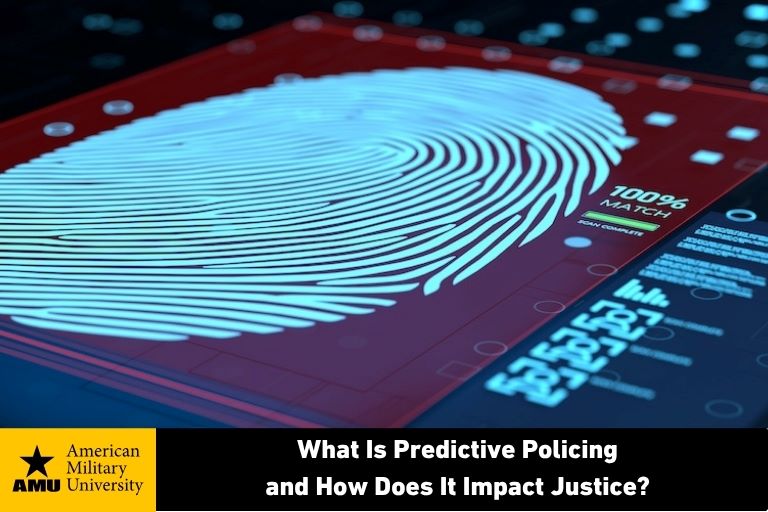By Dr. Matthew Loux and Bryce Loux | 11/03/2025

Over time, law enforcement officials must adjust to new problems and find practical solutions. These problems include:
- More complicated crimes
- Fewer available resources
- Demands for an increase in police accountability and transparency
To combat these issues, various law enforcement agencies around the world began using predictive policing. Predictive policing involves using advanced statistics, algorithms, and machine learning to predict where crimes may happen. In other words, law enforcement officers and their supervisors make an effort to find suspects and intervene before they receive 911 calls.
Predictive policing methods involve a system of crime prediction, crime pattern recognition, and crime analysis. All of that information is used to derive crime patterns and forge advanced systems to guide police department efforts.
The predictive policing system has its advantages, such as crime reduction and the proper allocation of public services. However, it’s equally important to not disregard the disadvantages of predictive policing, such as:
- Service inequality
- A lack of public trust, especially in minority communities
- Potential privacy violations
Historical Background of Predictive Policing
In the past, police agencies typically used pin maps to identify high-crime areas. These rudimentary visualizations helped law enforcement develop patrol strategies.
In the 1990s, the New York City Police Department CompStat predictive policing software changed police management by allowing real-time crime trend analysis. It also effectively enabled resource allocation in a dynamic, real-time manner and laid the foundation for predictive analytics.
In the 2000s, better data-driven policing was made possible by the convergence of powerful computing, sophisticated algorithms, and improved data storage. The use of machine learning for crime forecasting in the PredPol system (now Geolitica®), developed with the aid of the Los Angeles Police Department, was a pivotal moment in policing technology.
Now, police forces in a variety of countries around the world – such as the U.S., U.K. and Germany – use predictive analytics to analyze crime patterns and manage risk factors in their cities. They can identify probable criminal incidents that may occur in the future and disrupt them, reducing the burden on the criminal justice system.
Types of Predictive Policing
There are two main types of predictive policing:
- Place-based prediction – Involves a prediction of the time and location of future criminal activity.
- Person-based prediction – Identifies individuals who are likely to commit future crimes or become crime victims.
Both types of predictive policing depend on extensive data and advanced techniques for converting unprocessed data into meaningful intelligence.
Core Techniques of Predictive Policing
Predictive policing integrates conventional criminology and modern mathematical calculations. The principal techniques involve:
- Statistical crime mapping – Statistical crime mapping uses historic criminal data, such as arrest data, to detect “hot spots” where criminal activities concentrate. It typically utilizes geographic information systems (GIS) and time-series analysis.
- Machine learning algorithms – Machine learning algorithm models develop patterns from historical information to anticipate future offenses. These algorithms modify their forecasts in response to newly available data.
- Risk terrain modeling (RTM) – This approach associates certain elements of an environment (such as liquor stores, abandoned buildings, and transit stops) with the probability of crime. Risk terrain modeling helps to determine the risk elements, such as past arrests, that drive crime concentration.
- Social network analysis (SNA) – Social network analysis focuses on the connections between people in social units such as gangs, criminal associates, and co-offenders. It aids in the prediction of individuals most predisposed to violence or most likely to commit crimes again.
Technologies Supporting Predictive Policing
Tools such as PredPol, ShotSpotter Missions® (formerly known as HunchLab), and Palantir® combine statistical and machine learning techniques with real-time data for operational deployment. This technology includes computer systems that gather, process, and analyze large sets of data. This type of technology also makes use of:
- Big data analytics – Big data analytical techniques combine various datasets, such as crime reports, arrest records, social media data, and other forms of data. This information can be distilled into reports that can then be analyzed and used to make data-driven decisions.
- Artificial intelligence (AI) and machine learning (ML) – AI and ML can help detect hidden data patterns, improve the accuracy of data analysis, and aid in facial recognition.
- Geospatial Information Systems (GIS) – These systems can provide spatial visualizations for predicting crimes and to aid police agencies.
- Cloud computing – Cloud computing can help to provide real-time data.
- Surveillance cameras, drones, and license plate readers – These products help law enforcement conduct surveillance and record data for use in predictive systems.
Why Data-Driven Policing Is Useful
Predictive policing can be useful for various functions of law enforcement. These functions include:
- Patrol allocation – Police departments can use predictive policing, victimization patterns, and crime statistics to allocate resources. As a result, it permits more effective deterrence and increased police visibility by deploying police to crime hotspots.
- Crime prevention – Predictive policing technologies allow law enforcement to identify potential criminal activity and proactively intervene in crime prevention. Some interventions for preventing crime might include increased patrols in specific areas, more community engagement, or focused deterrence initiatives.
- Investigation – Predictive policing helps law enforcement narrow down potential suspects, identify similar crime patterns, or identify places where future crimes are most likely to occur.
- Violence prevention – Predictive policing systems help identify high-risk individuals for targeted intervention. These interventions may include social services, the monitoring of criminals who are on probation or parole, and community outreach efforts.
- Counterterrorism – To forecast potential terrorist activity and decrease the risk of an attack, predictive policing uses automated monitoring of travel patterns, financial transactions, and communications.
Benefits of Predictive Policing for the Criminal Justice System
Advocates of predictive policing point to its benefits:
- Crime reduction – Predictive policing is likely to reduce some property crimes, such as burglaries and theft.
- Resource efficiency – This type of policing aids with decision making, as well as the efficient distribution of resources such as funds and police officers.
- Proactive policing – Predictive policing shifts the focus of law enforcement departments to crime prevention, rather than reaction.
- Evidence-based strategy – This type of policing offers the opportunity to create a rational, evidence-based policing plan, rather than police officers simply relying on their gut instincts.
- Enhanced public safety – Police surveillance in crime-ridden areas is more likely to deter potential offenders.
Ethical Concerns of Predictive Policing
The benefits of predictive policing must be tempered with the potential concerns it raises, such as:
- Algorithmic bias – The historical crime data that an algorithm uses to produce its forecast can be riddled with racial and socio-economic bias. Biased data leads to biased predictions and enhances the impact of systemic inequities.
- Privacy and surveillance – The large-scale collection of social media data, plate numbers, and biometrics may threaten civil liberties of individual citizens. Critics of predictive policing foresee a “surveillance state,” constructed around the constant use of predictive systems to monitor people’s movements in their daily lives.
Transparency and Accountability
The proprietary nature of algorithms results in a lack of transparency in systems and procedures. Community trust is undermined when data-driven decisions and the processes that lead to them are difficult to understand.
There is a risk that reliance on predictive policing will deepen the alienation of marginalized populations, who are the primary targets of these systems. There are calls for counterbalancing predictive systems with independent audits, oversight, and public transparency.
Legal and Policy Implications
The legal and policy questions involving predictive policing are sophisticated and multi-layered, and include:
- Constitutional questions – In the U.S., predictive policing raises legal questions around the Fourth Amendment. This amendment protects citizens against unreasonable search and seizure and requires warrants to be issued only if there is probable cause.
- Regulation – There is a lack of consensus among policymakers on the extent to which predictive systems might be as regulated as other surveillance technologies.
- Legal restrictions on data – The European General Data Protection Regulation (GDPR) constrains predictive policing within a jurisdiction.
The Future of Predictive Policing
Predictive policing is a radical transformation in the approach of law enforcement to crime. However, the issues surrounding predictive policing are not about the use of technology in policing, but about its application, oversight, and assessment. Given the lack of bias, accountability, and transparency, predictive policing stands to contribute to inequity while eroding community trust in law enforcement.
Predictive policing is not meant to eliminate the need for human reason, morality, and public discussion. It is just one of many tools that should be utilized in the pursuit of justice, and its use should be guided by evidence and the will of the people.
The B.S. in Criminal Justice at AMU
Adult learners interested in improving their knowledge of criminal justice may be interested in seeking the online Bachelor of Science in Criminal Justice at American Military University (AMU). Taught by expert faculty members, the courses in this program include criminology, criminal investigation, and criminal profiling. Other courses involve various aspects of digital forensics, crime analysis, and criminal law.
For more details, visit AMU’s criminal justice degree program page.
Note: This degree program is not designed to meet the educational requirements for professional licensure or certification in any country, state, province or other jurisdiction. This program has not been approved by any state professional licensing body and does not lead to any state-issued professional licensure.
Geolitica is a registered trademark of PredPol, Inc.
Shotspotter Missions is a registered trademark of Shotspotter, Inc.
Palantir is a registered trademark of Palantir Technologies, Inc.
Dr. Matthew Loux is a criminal justice faculty member for the School of Security and Global Studies at American Military University. He holds a bachelor’s degree in criminal justice and a master’s degree in criminal justice administration from the University of Central Missouri State, a doctoral degree in management from Colorado Technical University, and a Ph.D. in educational leadership and administration from Aspen University.
Dr. Loux has been in law enforcement for more than 30 years. He has a background in fraud and criminal investigation, as well as hospital, school, and network security. Dr. Loux has researched and studied law enforcement and security best practices for the past 10 years.
Bryce Loux is an alumnus of American Public University. He holds a bachelor’s degree in fire science with a minor in criminal justice. Bryce is currently a student success coach.

